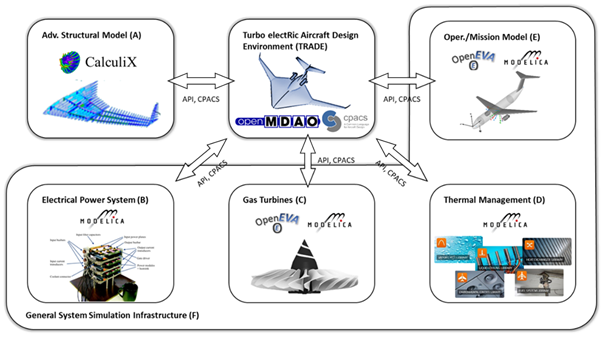TRADE Project
TRADE Turbo Electric Aircraft Design Environment
The ever-increasing amount of air travel and transport calls for substantial improvements in aircraft fuel efficiency and emissions. To reach such goals, the underlying concepts of aircraft must be reinvented. Local infusion of technology, for instance geared turbo fan technology on the power plant, is not enough. A few different approaches have been proposed. One of them is the electrification of primary power. Primary power is also generated by the jet engines on today's aircraft and propels the aircraft. It is a synonym for thrust. Aircraft with partially or fully electrified primary power systems are called hybrid or fully electric aircraft. Gas turbines on-board the aircraft generate electrical power, which is conducted through a power electronic sub-system to electric drives. These are integrated into distributed propulsion sub-systems, which propel the aircraft. Due to their construction, the distributed propulsion devices are substantially more energy efficient (for instance, as they enable boundary layer ingestion).
Such fundamentally different concepts are required as the benefit of incremental and local improvements to aircraft and their sub-systems are exhausted. Global optimization of the entire aircraft package is the only remaining way to achieve substantial performance improvements. Conventional engineering methods work poorly for such unconventional solutions, as they rely on statistical data of legacy products and established problem break-downs. This project develops a physics-based simulation and optimization platform with a focus on on-board systems and advanced structures that interfaces with existing conceptual design frameworks. Only like this the underlying trades can be uncovered, and the potential of the above-mentioned concepts can be realized.
The main objective of Turbo electRic Aircraft Design Environment (TRADE) is therefore to develop and utilize advanced simulation and optimization capabilities for hybrid propulsion system design space exploration and mission performance optimization at aircraft level.

Figure: Illustration of the design platform once populated with models of a turbo electric aircraft.
The TRADE Consortium consists of four parties.
- Modelon AB coordinates the project and provides the backbone of the system simulation in terms of modeling libraries and its Modelica compiler. Additionally, the company participates heavily in aircraft level, gas turbine, and thermal system modeling.
- Mälardalen University focuses on the gas turbine modelling, whole-engine and aircraft-level system integration, as well as lead the detailed system level and mission level assessments and optimization studies.
- The University of Nottingham participates mainly in the development of the electrical sub-system models, aircraft-level integration and configuration assessments.
- Technical University Berlin participates mainly in the development of the aircraft structural model as well as the configuration assessments.
This project has received funding from the Clean Sky 2 Joint Undertaking under the European Union’s Horizon 2020 research and innovation programme under grant agreement number 755458.